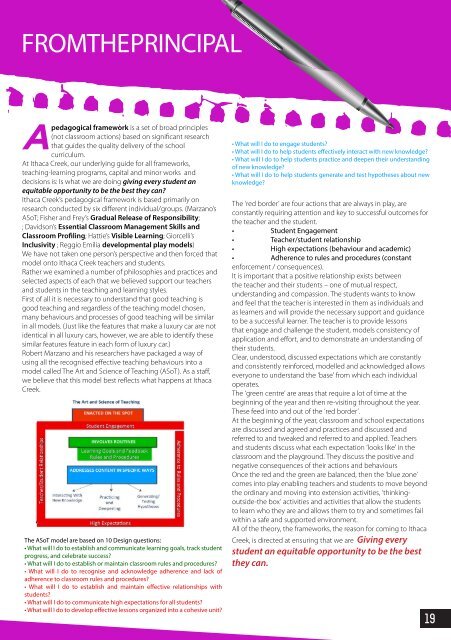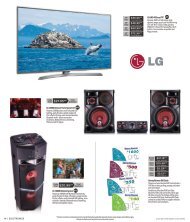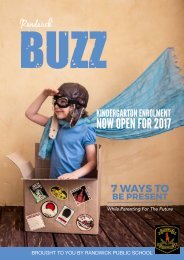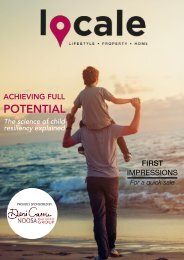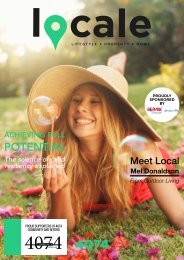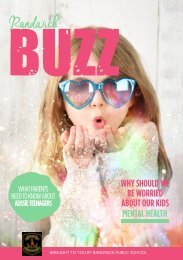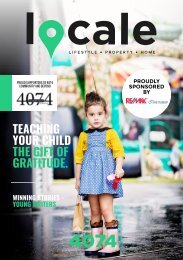ITHACA_November_PRINT
You also want an ePaper? Increase the reach of your titles
YUMPU automatically turns print PDFs into web optimized ePapers that Google loves.
FROM THE PRINCIPAL<br />
pedagogical framework is a set of broad principles<br />
(not classroom actions) based on significant research<br />
that guides the quality delivery of the school<br />
curriculum.<br />
At Ithaca Creek, our underlying guide for all frameworks,<br />
teaching-learning programs, capital and minor works and<br />
decisions is: Is what we are doing giving every student an<br />
equitable opportunity to be the best they can?<br />
Ithaca Creek’s pedagogical framework is based primarily on<br />
research conducted by six different individual/groups. (Marzano’s<br />
ASoT; Fisher and Frey’s Gradual Release of Responsibility;<br />
; Davidson’s Essential Classroom Management Skills and<br />
Classroom Profiling; Hattie’s Visible Learning; Giorcelli’s<br />
Inclusivity ; Reggio Emilia developmental play models)<br />
We have not taken one person’s perspective and then forced that<br />
model onto Ithaca Creek teachers and students.<br />
Rather we examined a number of philosophies and practices and<br />
selected aspects of each that we believed support our teachers<br />
and students in the teaching and learning styles.<br />
First of all it is necessary to understand that good teaching is<br />
good teaching and regardless of the teaching model chosen,<br />
many behaviours and processes of good teaching will be similar<br />
in all models. (Just like the features that make a luxury car are not<br />
identical in all luxury cars, however, we are able to identify these<br />
similar features feature in each form of luxury car.)<br />
Robert Marzano and his researchers have packaged a way of<br />
using all the recognised effective teaching behaviours into a<br />
model called The Art and Science of Teaching (ASoT). As a staff,<br />
we believe that this model best reflects what happens at Ithaca<br />
Creek.<br />
The ASoT model are based on 10 Design questions:<br />
• What will I do to establish and communicate learning goals, track student<br />
progress, and celebrate success?<br />
• What will I do to establish or maintain classroom rules and procedures?<br />
• What will I do to recognise and acknowledge adherence and lack of<br />
adherence to classroom rules and procedures?<br />
• What will I do to establish and maintain effective relationships with<br />
students?<br />
• What will I do to communicate high expectations for all students?<br />
• What will I do to develop effective lessons organized into a cohesive unit?<br />
• What will I do to engage students?<br />
• What will I do to help students effectively interact with new knowledge?<br />
• What will I do to help students practice and deepen their understanding<br />
of new knowledge?<br />
• What will I do to help students generate and test hypotheses about new<br />
knowledge?<br />
The ‘red border’ are four actions that are always in play, are<br />
constantly requiring attention and key to successful outcomes for<br />
the teacher and the student.<br />
• Student Engagement<br />
• Teacher/student relationship<br />
• High expectations (behaviour and academic)<br />
• Adherence to rules and procedures (constant<br />
enforcement / consequences).<br />
It is important that a positive relationship exists between<br />
the teacher and their students – one of mutual respect,<br />
understanding and compassion. The students wants to know<br />
and feel that the teacher is interested in them as individuals and<br />
as learners and will provide the necessary support and guidance<br />
to be a successful learner. The teacher is to provide lessons<br />
that engage and challenge the student, models consistency of<br />
application and effort, and to demonstrate an understanding of<br />
their students.<br />
Clear, understood, discussed expectations which are constantly<br />
and consistently reinforced, modelled and acknowledged allows<br />
everyone to understand the ‘base’ from which each individual<br />
operates.<br />
The ‘green centre’ are areas that require a lot of time at the<br />
beginning of the year and then re-visiting throughout the year.<br />
These feed into and out of the ‘red border’.<br />
At the beginning of the year, classroom and school expectations<br />
are discussed and agreed and practices and discussed and<br />
referred to and tweaked and referred to and applied. Teachers<br />
and students discuss what each expectation ‘looks like’ in the<br />
classroom and the playground. They discuss the positive and<br />
negative consequences of their actions and behaviours<br />
Once the red and the green are balanced, then the ‘blue zone’<br />
comes into play enabling teachers and students to move beyond<br />
the ordinary and moving into extension activities, ‘thinkingoutside-the<br />
box’ activities and activities that allow the students<br />
to learn who they are and allows them to try and sometimes fail<br />
within a safe and supported environment.<br />
All of the theory, the frameworks, the reason for coming to Ithaca<br />
Creek, is directed at ensuring that we are Giving every<br />
student an equitable opportunity to be the best<br />
they can.<br />
19


